Yeast-free dough

It is understandable that almost any pastry is nothing more than a culinary product, which is made from various types of dough. That is why it contains a considerable amount of carbohydrates, proteins, vitamins, minerals and fats. All these elements, put together, give the body the necessary energy charge that is so needed throughout the day.
Due to the great nutritional value, flour products are quite high in calories, which is important for people with insufficient body weight, but for those prone to completeness, the issue of eating such products is quite acute. But be that as it may, extra pounds can appear only in the event of excessive consumption of rubbish. In addition, in order to be sure how exactly such a treat will affect your appearance, you need to know what kind of dough the pastry is made from.
Types of yeast-free dough
So, absolutely all types of dough are divided into 2 groups: yeast-free dough and yeast. There are a lot of types of yeast-free dough, in turn: biscuit, fresh, custard, shortbread, puff and some others. It is known that all pastry cooking products must have a porous structure in order for hot air to penetrate the product without problems during baking. So to create this porosity, special substances are used, which are called disintegrants. From the name it is clear that for yeast test it is yeast.
As for yeast-free dough, there are 2 types of loosening techniques: chemical and mechanical. The first includes ammonium carbonate and drinking water. When baking the product, these elements begin to decompose and release carbon dioxide, which gives the finished dish a porous structure.
And the mechanical methods of loosening some types of yeast-free dough include rolling out (in the case of puff dough) or beating (this applies to biscuits). In addition, some substances found in milk and eggs have the same effect on the dough as mechanical loosening techniques - giving it porosity.
It is worth noting that the general rule for all types of yeast-free dough is the use of eggs and wheat flour without adding yeast. For example, to make biscuit, you need eggs, flour and sugar, but for a shortbread product you will also need butter, which is often replaced by margarine. As for puff dough, egg whites are often used instead of eggs.
A rather interesting version of yeast-free dough is custard dough, which necessarily includes a very large amount of eggs, flour and butter. It is so called in connection with the cooking method, which is characterized by brewing these products in boiling water.
In cooking and confectionery, in particular, a large number of a wide variety of dishes are prepared from yeast-free dough. These can be buns and cakes, pies with and without filling, cool and puffs, as well as cakes that decorate with berries, fruits or all kinds of creams. However, with such a variety of naivosky culinary creations, one should not forget that the calorie content of yeast-free dough is quite high, so one should not get involved in it, adhering to the rule of the middle ground.
non-yeast dough 337.2 kCal
Energy value of yeast-free dough (Ratio of proteins, fats, carbohydrates - ju):
Proteins: 5.9 g (~ 24 kCal)
Fats: 18.5 g (~ 167 kCal)
Carbohydrates: 39.3g (~ 157 kCal)
Energy ratio (b | y): 7% | 49% | 47%
 Español
Español Français
Français Português
Português Русский
Русский 简体中文
简体中文 繁體中文
繁體中文 日本語
日本語 한국어
한국어 العربية
العربية Türkçe
Türkçe Қазақ
Қазақ Deutsch
Deutsch Italiano
Italiano Українська
Українська
